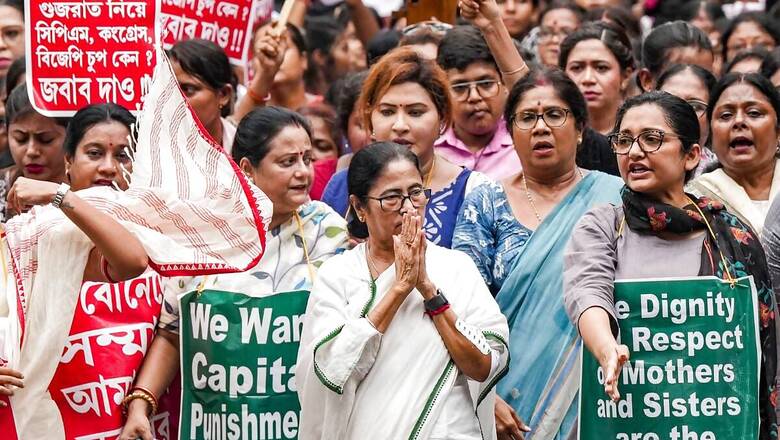
views
The chilling rape and murder of a postgraduate trainee doctor at RG Kar Medical College and Hospital in Kolkata has sparked nationwide protests demanding justice for the deceased and the safety of women in workplaces and public spaces. These spontaneous protests, where the public is taking to the streets holding candles, reflect widespread frustration over the ongoing insecurity faced by women both in public and at work. This horrific case has once again highlighted how women continue to remain unsafe, despite the existence of laws meant to protect them.
However, it is the failure of the state’s Trinamool Congress-run government, led by party supremo Mamata Banerjee, to properly handle the case that has intensified public anger. The Supreme Court, which took suo motu cognisance of the matter, has strongly criticised the Mamata government for its mishandling of the case.
Many were astonished to see Chief Minister Banerjee, who also holds the positions of home minister and health minister, leading protests against this crime and demanding the death sentence for the perpetrators. Isn’t this a desperate attempt by Banerjee to divert attention from her government’s failures? It certainly seems so.
Growing anti-incumbency against TMC government
Although the ruling party increased its seats to 29 in the recently concluded 2024 Lok Sabha election, up from 22 in the 2019 election, the results revealed chinks in the TMC’s armour. The party did not perform well in urban areas. The BJP, which saw its seats reduced to 12 in this Lok Sabha election from a stellar 18 in 2019, was ahead in 73 out of 125 municipalities and corporations. Currently, except for the Taherpur Municipal Council, ruled by the Left, the TMC is in power in all municipalities and corporations. Even in the Kolkata Municipal Corporation, the largest and most prestigious urban body, the saffron party, which currently has 3 seats, led in 47 out of 144 seats.
Clearly, the TMC’s grip on urban voters is slipping away. The high rate of unemployment due to a lack of industries, coupled with the jobs scam in the government sector, has tarnished the image of the TMC government among urban voters. Additionally, growing dissent among a significant section of these voters is linked to the involvement of TMC leaders in spreading violence, particularly on election days, to prevent people from exercising their right to vote. This intimidation is especially evident during municipal elections, which have almost become a farce since the Mamata-led TMC government came to power. The urban voters account for more than 30 per cent of the electorate in the state.
Mamata Banerjee’s protest only reveals TMC’s limited tactics
With the protests against her government showing no signs of slowing down, Mamata Banerjee was left with no option but to resort to her tried and tested formula of street agitation—an attempt to distract voters from her government’s failures. She is concerned that if these mass protests continue, anti-incumbency sentiment will only gain traction among the protesters—signs of which are already emerging. Prolonged protests are also likely to tarnish her image among women voters, a key group behind her electoral success.
Moreover, she fears that the unrest may not only exacerbate dissent in urban areas but could also spread to rural regions, where the TMC’s stronghold remains intact. However, her participation in the protests has inadvertently exposed the TMC’s vulnerabilities—that the ruling party has limited arrows in its quiver.
Currently, the TMC’s strength lies in its rural voter base, which includes beneficiaries of various welfare schemes. A prominent example is the women-centric Lakshmir Bhandar scheme, through which Rs 1200 is given to SC/ST women and Rs 1000 to women from the general category. Over 2.11 crore of the state’s 3.73 crore women voters benefit from this scheme. Another key support base for the TMC is the state’s 28 per cent Muslim electorate. It’s well-known that Mamata Banerjee uses the fear of the BJP to secure solid backing from this demographic.
Another advantage for the TMC is the division of votes among the Opposition. In 15 seats, the TMC’s winning margin against the BJP was less than the combined votes secured by the Left-Congress alliance. However, in the case of strong anti-incumbency, even this division might not suffice, as seen recently in other states where voters consolidated behind a single opposition party to defeat the ruling party.
However, if the rising unemployment in the state isn’t addressed, the Rs 1200 or Rs 1000 provided through welfare schemes won’t be enough to save the TMC in the long run. The lack of job opportunities, combined with the growing wealth of TMC leaders—many of whom face corruption allegations—could also erode the party’s prospects sooner or later if the current situation persists or worsens.
As of now, the TMC’s only relief is that its main opposition, the BJP, isn’t particularly strong. As long as the saffron party remains her primary opposition, Mamata Banerjee can easily exploit the fear among Muslims to rally them behind her by playing the communal card. However, the current protests have revealed cracks in the TMC’s armour, and if these issues are not properly addressed in time, their impact is likely to be felt in the 2026 state Assembly polls.
Sagarneel Sinha is a political commentator and tweets @SagarneelSinha. Views expressed in the above piece are personal and solely those of the author. They do not necessarily reflect News18’s views.
















Comments
0 comment